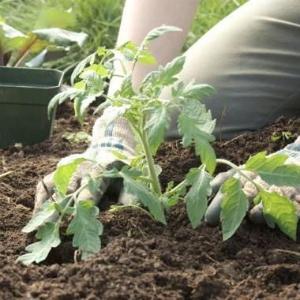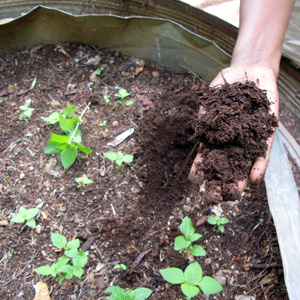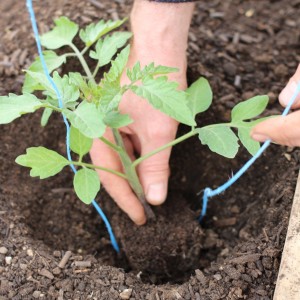How to prepare the soil for tomatoes in the greenhouse for maximum fruiting
More than 60 million tons of tomatoes are produced annually in the world. Agronomists have learned to cultivate this vegetable almost everywhere. Achieving good results in terms of yield is also obtained through the preparation of suitable soil.
How to prepare the soil for tomatoes in a greenhouse for a bountiful harvest and what to do to avoid the spread of diseases and pests? We will tell you more about this and not only in our article.
The content of the article
What soil do tomatoes like?
Soil for tomatoes is advised to choose with the following properties:
- loose, not compacted, which means air and water permeable;
- quickly warmed up;
- rich in nutrients (nitrogen, potassium, phosphorus) and minerals (calcium, magnesium);
- slightly acidic, that is, with a pH value of 5.5-6.5 (lower numbers indicate an acidic reaction, and more than 7 indicate an alkaline one);
- not infected with pests and infectious diseases.
The following composition meets the listed requirements: peat - 60%, sand - 20%, compost - 20%.
Training
Preparation measures depend on the type of soil.
To determine the type of soil, a small test is carried out: a handful of earth is slightly moistened, kneaded, rolled into a ring about 5 cm in diameter.
The results are evaluated as follows:
- The ring is obtained with ease - the soil is clayey, heavy. Heats up for a long time, has high acidity.
- The sausage turns out, but the ring cracks - in the loam area. The acidity is optimal for tomatoes, retains moisture well.
- The sausage crumbles - the soil is light, the so-called sandy loam. Heats up quickly and dries quickly, as a rule, poor in nutrients, has an alkaline reaction.
Structure
To change the structure of clay soil during autumn digging, 1-2 buckets of rotted manure or peat are added per 1 m2. For better drainage, river sand can be added: one bucket per 1 m2. Baking powder should be used every fall. It is useful to settle earthworms on the site, which loosen the ground well.
It is enough to loosen the loam and add humus and mineral fertilizers.
Organic matter will help to increase the cohesion of particles of sandy loam soil: at least two buckets of humus, peat or rotten manure per 1 m2.
Acidity
Ready-made indicators will help to independently determine the acidity of the substrate: strips of paper soaked in special reagents, or inexpensive field pH meters. They are sold at gardening stores.
The large plantain, creeping buttercup, sedge, and horsetail growing on the site speak of acidity.
The increased acidity is eliminated by liming. On tomato beds, the procedure is carried out only in the fall.
Deacidify the soil with substances or compounds with an alkaline reaction:
- slaked lime;
- dolomite flour;
- chalk;
- wood ash.
4-5 kg of slaked lime per 10 m2 are introduced into clay soils, from 1 to 1.5 kg into sandy loam, and then dug up.
Important! Liming is carried out no more than once every five years.
To maintain a comfortable pH level for plants, wood ash is scattered over the area every autumn before cultivation.
Predecessors
Tomatoes should not be planted from year to year in the same area, as well as after potatoes, eggplants, and peppers. Cucumbers, zucchini, cabbage, carrots, and legumes are considered good predecessors.
When grown indoors, it is better to start 1-2 small greenhouses and alternate plantings. If you use one greenhouse, you need to update the soil.
Fertilizers
Tomatoes are demanding on the content of nutrients and do not give a good harvest on poor soil.
Organic matter (rotten manure, humus, compost) is introduced during the autumn digging. Clay soils are recommended to be fertilized once every four years, sandy loam - once every two years.
At the same time, the beds are treated with mineral preparations containing potassium and phosphorus: monophosphate or superphosphate. Bone meal is often used as a phosphorus fertilizer. Nitrogen fertilizers are best applied in spring.
If time permits, it is good to enrich the substrate with green manure: sowing cereals, legumes or mustard on the plot for tomatoes.
Humidity
Tomatoes need areas with good drainage. If the groundwater is close to the soil surface, it is better to choose elevated areas for the beds. Planting in swampy ground leads to root rot and death of tomatoes.
Optimal soil moisture for tomato growth is 75-80%.
Read also:
How and how often to water tomatoes in the greenhouse.
What is tomato bacteriosis, why does it appear in the greenhouse.
Why are tomatoes in the greenhouse fattening and what to do if this happens.
Tillage
Autumn soil preparation in a greenhouse for tomatoes consists of several steps:
- In the fall, it is necessary to remove the remains of all plants, and it is better to remove them from the root. On the remaining plant debris, parasites and foci of diseases remain until spring.

- Garters and trellises must be removed for the winter.
- Rinse the greenhouse frame and fence with a hose. If there have been cases of damage by pests or infections, treat the structure with a bleach solution: 400 g per bucket of water.
- Prepare fertilizers: compost, humus. Spread one bucket per 1 m2 over the garden. It is good to dig up the beds along with organic matter.
- Apply potassium and phosphorus preparations, with a pitchfork or a hoe, close up to a depth of 5-7 cm, at the same time loosening the soil and removing small weeds.
Screening
Screening is used as an additional measure of loosening, structuring and oxygenation. At the same time, it is possible to get rid of pebbles, remnants of roots and other debris. It is easier to transplant seedlings into sifted soil, the roots of the shoots are not injured.
For sifting, meshes with a mesh size of 6-12 mm are used. You can also use a construction sieve.
Heat treatment
Heat treatment destroys insect pests and their larvae, spores of fungi, pathogens.
The most common technique is soil freezing. To do this, the cover is removed from the film greenhouses, and the buildings made of polycarbonate or glass are left open. After freezing, the soil is covered with a layer of snow.
Spilling the beds with boiling water kills pathogens and warms up the soil. This method is used only in the spring before planting seedlings.
Disinfection
In autumn work in closed ground, disinfection of the soil must be included.
 For disinfection from late blight, spider mites, rot and scab, a three percent solution of copper sulfate is used. For the same purpose, a solution of potassium permanganate is used: 5 g per 10 liters of warm water.
For disinfection from late blight, spider mites, rot and scab, a three percent solution of copper sulfate is used. For the same purpose, a solution of potassium permanganate is used: 5 g per 10 liters of warm water.
In spring, greenhouse surfaces and soil are additionally treated with Fitosporin. To prepare the solution, take 5 g of the drug per 10 liters of water. Spraying is carried out about a week before planting tomatoes.
Conclusion
Tomatoes are a crop sensitive to soil quality. She needs a loose, well-aerated, permeable and nutrient-rich soil.
If the land on the site or in the greenhouse does not meet the requirements, the situation can and should be corrected. Sand, peat, rotted organic matter should be added to heavy clay soil, and organic matter and mineral fertilizers should be added to the sandy loam. The acidity is controlled by liming. Digging, regular loosening, reasonable feeding and timely disinfection make the soil ideal for growing tomatoes and obtaining a rich harvest.